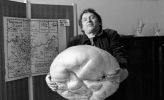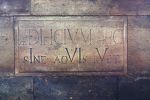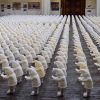A reviewed and updated version of a text written in 1994, originally published in the catalogue FUNGUS.
This text and illustrations, which the reader will find in a humble little booklet hidden in a green paper tube recycled from gas masks, are attempts to redeem at least a few images from oblivion and entropy. The depicted scenes took place in the buildings in the little town of Plasy. Here the history of the place is inscribed on the walls of the monastery, much like the geological layering revealed by flood on the banks of a river (there is a connection here between the element of water and time: the name Plasy supposedly means, in ancient Celtic, a place where one can cross the river). Founded 850 years ago, the Plasy monastery is aptly situated in a meander of the river Střela. Both the river and underground streams run underneath the structure of the building. In a way, the stability and future of the structure depends on the fragile homeostasis of its immediate surroundings.
The Baroque architect incorporated the flow of the stream into the basements: the river runs through and under the structure, and brooks were channeled from the surrounding hills to the fountains in the garden. The architecture is connected to the land with invisible ties and the environment changes throughout time. A warning is carved in a stone inside of the convent: without water the edifice will be in ruins. In the last decades, this has become a source of real threat, as the polluted water started to dissolve the stones and the wooden beams of the founding structure. The environment takes revenge, slowly destroying the stone subbterranean structure of the Convent, while lignicolous fungi attack and decay the wooden beams of its floors and roofs. Nature reclaims that which was taken by man.
The Place
The theme of the symposium The Inquiry of Place was chosen as a form of exploiting the visible and invisible ties which link the human element with the landscape: it was a challenge to come and act in particular locations. Nineteen visual artists visited Plasy to search, to engage in dialogue, to recover its history, and its morphology. Each artist found their specific place and each articulated her/his specific method. Miloš Šejn undertook "speleo-aesthetic" research of the sonic, architectural and "thermodynamic" structures of the underground water system, and its relationship with the entire building of the Convent. In his final evening performance and his audio-visual installation, he managed to link the cold underlying layers with the warm cylindrical body of the Saint Benedict Chapel. Charlie Citron expanded the spatial and conceptual framework: he discovered and accented the communication networks between the distant and the near, between life and death. For his "Fly Route" installation, he mailed 100 envelopes by post filled with a hundred dead bodies of flies which he found during his first visit on the floor of the chapel. Each envelope included drawings and was sent out around the world to return back to Plasy and to the place where flies were born and where they died. Jan Ambrůz constructed a transparent tube and created a perpetual, reflexive "glass kaleidoscope" inside of the granary. Stefan Pfaff-Hosch simply cleaned out all the rubbish from the former summer refectory which, during Metternich times, became the granary. In this way, he exposed the structure and the transformation of its ideologies and its economies. In general, the environmental context became, in a way, more accented and important than the physical artifact itself.
On Site / Off Site
Naturally, the old monastery is not the white cube of a gallery or a museum of contemporary art. Here, artifacts can be hardly separated from their environment. The artist working in such a context should prove his/her sensitivity, sense of orientation, playfulness, improvisation and flexibility. It can happen that the artwork almost or entirely "disperses" or dissolves within the space. At certain times, it may be difficult to distinguish between the space and that which was meant as the installation or intervention.
In situations outside of the aesthetic, economic and ethical ramifications of gallery spaces, the role and the trace of an artist perhaps become more transparent, anonymous, and humble. It is also necessary to pay attention to both the history and the surrounding environment, and to challenge the visitors’ imagination as well. Plasy is situated in the middle of a rural landscape, and is relatively far from urban and industrial centers. The contemporary urban environment suppresses the essence of its landscape with a constant stream of signs, information, speed and velocity, time schedules, goods, or neon lights. Its structure and geology is compressed into perceptual noise. In comparison, the rural landscape can be encountered as a manifestation of open space, slowness and of duration.
The monastery serves as an intersection of "domus" and landscape. There is no choice but to slow one´s tempo, to start observing, listening and silently inquiring after concealed meanings and shapes. One can even lose one´s way in the labyrinthine passages. One can wander under the clock tower and through the mirroring corridors of the Convent. The Cloister is a complex, almost autonomous environment, an enclosure, a junction of the inner landscape (the herb garden in the center), sacred spaces of the temple, a refuge, domus. And - according to famous Max Weber´s theory - predecessor of Age of Industry and the birth of Megalopolis.
Early Christian monastic architecture had the purpose of sheltering against the dangerous wasteland outside. It provided a dwelling protecting a fragile nest of culture and religion behind its high quadrant of stone walls. The sacred trees inhabited by pagan gods had to be cut down, and the Aesculapian snake – symbol of defeated desert was attached to the cross on the roof of the Cloister.
The Monastery was also evocation of the Garden of Eden in the form of a green courtyard in the center of surrounding quadrant of buildings with chapels, dormitories and refectories. Only nomadic hermits and the Franciscan order approached Nature as a friendly environment which was shaped and maintained by God. Cistercians established their monasteries in "places remote from human intercourse," and in this sense the monastery remains a dwelling partly open to the landscape, and also a location of communal life, outside of the megalopolises.
Brethrens during the eleventh and twelfth century left towns and searched for wastelands, remote places on "rocks and morass," where proximity to God would not be disturbed by the secular, mundane and vanity of urban decadence. The Baroque period softened these strictly ascetic regulations of early monastic orders and framed more mild and harmonious conjunctions of landscape and architecture. The bucolic scenery was part and parcel of the dominance of human settlements. The closure of the Baroque period also meant the decline of monastic architecture and the rise of harsh exploitation of the landscape by industry.
The artistic idiosyncratic concept of Jan Blažej Santini-Aichel´s architectonic symbiosis of the organic and inorganic elements in construction and ornamentation also corresponds with his idiosyncratic approach towards the shaping of the entire landscape and of the building’s surroundings. Santini´s important realizations in the landscape – especially his Church of the Annunciation and the Cistercian Provost in Mariánská Týnice, the fragment of the Convent in the Plasy Monastery, or the Pilgrimage Church of Jan Nepomuk in Zelená hora near Žďár nad Sázavou – embody his unusual and genuine sensitivity for place, for location, and for topology.
In his time, Nature was partly still cherished under the Divine blessing. The successive revolutionary development of urban culture and the rise of industrial towns quickly cut off the enigmatic symbol of the "country-side" (as the “side of the country”) and of land-scape. The connection between nature and "domus" – the dwelling and house – suffered from a new transition of the Modern and it´s religion predicated on progress and future. In his book The Inhuman: Reflections on Time, Jean-François Lyotard writes: “Nature changed in the romantic landscape painting of the bourgeois salons. This process is continuing and the consequences are visible in the degradation of the rural and the concentration of the cultural values in towns in the 19th century. The megalopolis transformed 'res domesticae' into 'residence,' into 'egalitarian citizenship, to the workforce and to another memory, the public archive, which is written, mechanographically operated, electronic. It breaks up god-nature. With another regulation of space – time set in place, it is in relation to this, that the bucolic regime is perceived s a melancholic survival. Sad tropics (Tropiques Tristes) seen from the north.'1
The non-site gradually overruled the site. The approaching phantom of a global village probably means proximity of economic laws, the victory of the texture, of silicone communication networks, lukring expansion of suburbia, spreading brown fields and post-industrial ruins. It also means a decline of the intimacy of the domesticated Baroque landscape, and heralds a transition from the garden to the industry of the greenhouse. This is all framed within the backdrop of climatic change.
Much like the motorisation of mankind changed our perception and our conception of space, the new space appears solely in its flattened, reduced forms: “Volume leaves the field to surface, and any overall view surrenders to visual signals spaces out along fixed trajectories laid down in the plan. An extraordinary – indeed unthinkable, impossible – confusion gradually arises between space and surface, with the latter determining a spatial abstraction which it endows with a half-imaginary, half-real physical existence. This abstract space eventually becomes the simulacrum of a full space which was formerly full in nature and history.”2
The Plasy Monastery is a residue of the agricultural, rural, of ruined history, serene in its relationship with nature, its current state of decay and desolation. Today, since the industrial part of monastic economy is almost forgotten, its history can be interpreted as part of eco-topy, of utopian ideas preoccupied with the beliefs of resurrection of the rules of green communities, of Man as Gardener.
Lines and Circles
Every place, every kind of landscape, whether bucolic or urban, has a different rhythm, timeline and duration. In certain places, time runs inevitably forward, while in other places time flows rather slowly and in ellipses, circles or : spring, summer, fall, winter, harvest and feasts. The richness of structures of the inner landscape of the Plasy monastery is composed of features such as symmetrical repetition, illumination, reflections of light, sonical echoing, fragile balance between heavy masses of walls and the lightness of sound interferences; between the surrounding landscape and the interior of the 'domus,' between outside and inside, the exo- and the endo- entities.
An awareness of the space’s qualities, of its genius loci, became inspiration for the curators and initiators of Fungus. For several weeks, the monastery changed back from a touristic venue into a dormitory, a workplace and a laboratory. The intention was not to place or displace physical artifacts in architecture, or to leave behind traces, produce artistic and aesthetic statements, marks, or confessions. Rather, it became a test, a challenge for re-articulation, for rediscovering models of possible co-existence between the human and the non-human; all taking place in a test situation within a small environmental niche.
The project was conceived as an allusion towards the past, an environmental shift, transgressing the "safe frontiers" of "Genuine Art." Nevertheless, 'eco-art' was not a direct inspiration for artists and curators. Its title – Fungus, or Mushroom – was rather an ironic and symbolic gesture towards the cycles of living and dying trees. In fact, the borders of the Black Triangle – the scarred landscape full of dead, dry spruces, pines, oaks, the fossil land without plants, without fungi, and with no sound of insects, is just a one-hour drive from Plasy.
Forest, Fungus and Plastic Dwarfs
The remaining forests which once covered huge parts of Central Europe, are steadily disappearing. What remains are green spots, islands, natural parks, resorts. Animals, fungi, plants and trees survive in limited biotopes, niches, strips, and are surrounded by agricultural wasteland, or by industrial zones, cut through by the killing fields of highways. With forests also disappeared the world of imagination, with its legends and fairy tales. It disappeared or withdrew and survives only in the entertainment parks, B-rated films and fantasy TV series. All that remains of the richness of the Dark Woods’ inhabitants are Disney-like dwarfs, cast from plastics, constantly standing in suburban gardens, and crowding the markets of the Czech-German border. Those infantile pop symbols of defaced Greenland are usually accompanied by beautiful red mushrooms with white spots – the Amanita Muscaria. The magic mushroom played quite an important role in village mythology: it was the guide for communion with Gods and Ancestors. Beside this role, the mushroom is also a symbol of the eternal and sacred metamorphosis of living soil, symbolizing the production of humus, growth, death, the transmutation of elements, and resurrection. It is a guide for creatures of the night, gestalt of the unconscious, the medium for hallucination and living proof of the incredible variety of the shapes and colours of Nature.
The extinction or raising of Celisium toxicity of fungi is a sign of a harmed, wounded nature, and of a polluted environment. For Fungus, the affinity with the universe of fungi was a gesture to try to improve our understanding of the essence of the fragile turning point we are experiencing on planet Earth – the planet which we, until recently, shared with many other living creatures. This recycled catalogue is a tiny contribution towards the ongoing dialogue between mankind, nature and culture.
English editor: Vít Bohal (original translator unknown)
(I am aware that production of this catalogue and the entire project contributed to an acceleration of the environmental damage.)
Jean-Francois Lyotard, “From Domus to the Megalopolis” The Inhuman: Reflections of Time (Stanford: Stanford University Press, 1991) p. 200.
Henri Lefebvre, _The Production of Space _(Edition Antropos, 1974).






